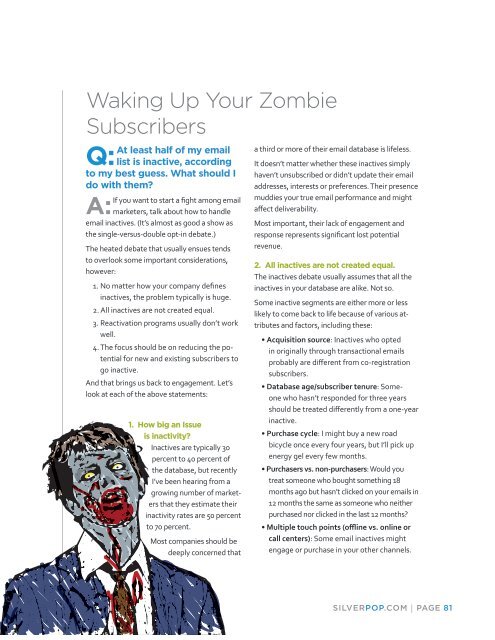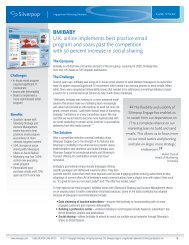eBook - Silverpop
eBook - Silverpop
eBook - Silverpop
Create successful ePaper yourself
Turn your PDF publications into a flip-book with our unique Google optimized e-Paper software.
Waking Up Your Zombie<br />
Subscribers<br />
At least half of my email<br />
Q: list is inactive, according<br />
to my best guess. What should I<br />
do with them?<br />
If you want to start a fight among email<br />
A: marketers, talk about how to handle<br />
email inactives. (It’s almost as good a show as<br />
the single-versus-double opt-in debate.)<br />
The heated debate that usually ensues tends<br />
to overlook some important considerations,<br />
however:<br />
1. No matter how your company defines<br />
inactives, the problem typically is huge.<br />
2. All inactives are not created equal.<br />
3. Reactivation programs usually don’t work<br />
well.<br />
4. The focus should be on reducing the potential<br />
for new and existing subscribers to<br />
go inactive.<br />
And that brings us back to engagement. Let’s<br />
look at each of the above statements:<br />
1. How big an Issue<br />
is inactivity?<br />
Inactives are typically 30<br />
percent to 40 percent of<br />
the database, but recently<br />
I’ve been hearing from a<br />
growing number of marketers<br />
that they estimate their<br />
inactivity rates are 50 percent<br />
to 70 percent.<br />
Most companies should be<br />
deeply concerned that<br />
a third or more of their email database is lifeless.<br />
It doesn’t matter whether these inactives simply<br />
haven’t unsubscribed or didn’t update their email<br />
addresses, interests or preferences. Their presence<br />
muddies your true email performance and might<br />
affect deliverability.<br />
Most important, their lack of engagement and<br />
response represents significant lost potential<br />
revenue.<br />
2. All inactives are not created equal.<br />
The inactives debate usually assumes that all the<br />
inactives in your database are alike. Not so.<br />
Some inactive segments are either more or less<br />
likely to come back to life because of various attributes<br />
and factors, including these:<br />
• Acquisition source: Inactives who opted<br />
in originally through transactional emails<br />
probably are different from co-registration<br />
subscribers.<br />
• Database age/subscriber tenure: Someone<br />
who hasn’t responded for three years<br />
should be treated differently from a one-year<br />
inactive.<br />
• Purchase cycle: I might buy a new road<br />
bicycle once every four years, but I’ll pick up<br />
energy gel every few months.<br />
• Purchasers vs. non-purchasers: Would you<br />
treat someone who bought something 18<br />
months ago but hasn’t clicked on your emails in<br />
12 months the same as someone who neither<br />
purchased nor clicked in the last 12 months?<br />
• Multiple touch points (offline vs. online or<br />
call centers): Some email inactives might<br />
engage or purchase in your other channels.<br />
SILVERPOP.COM | PAGE 81







